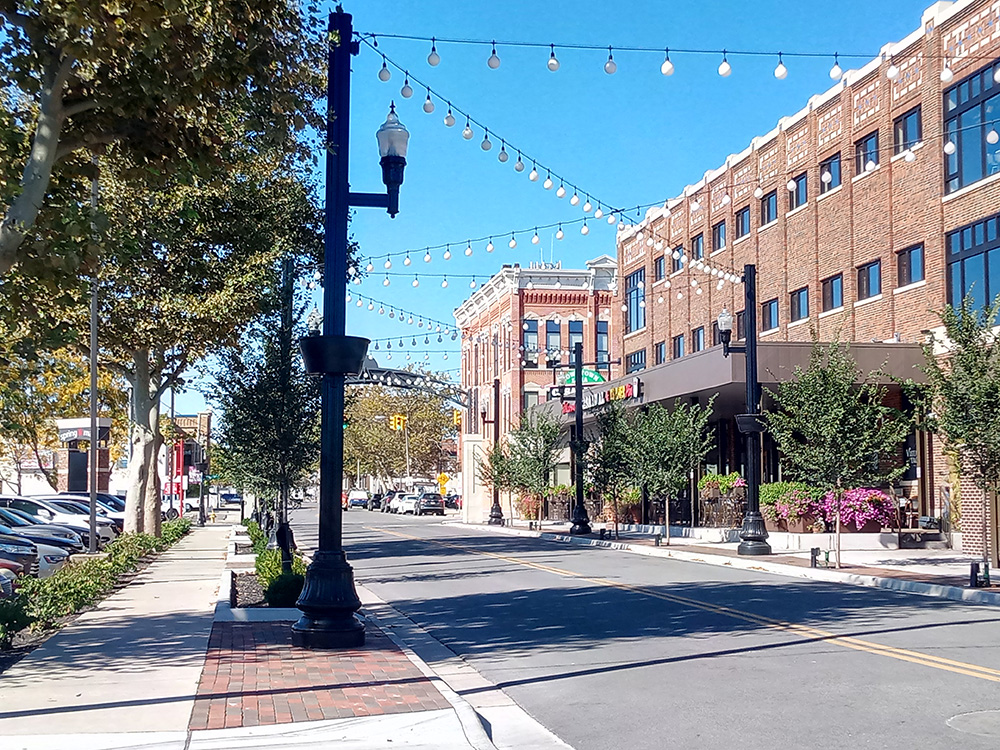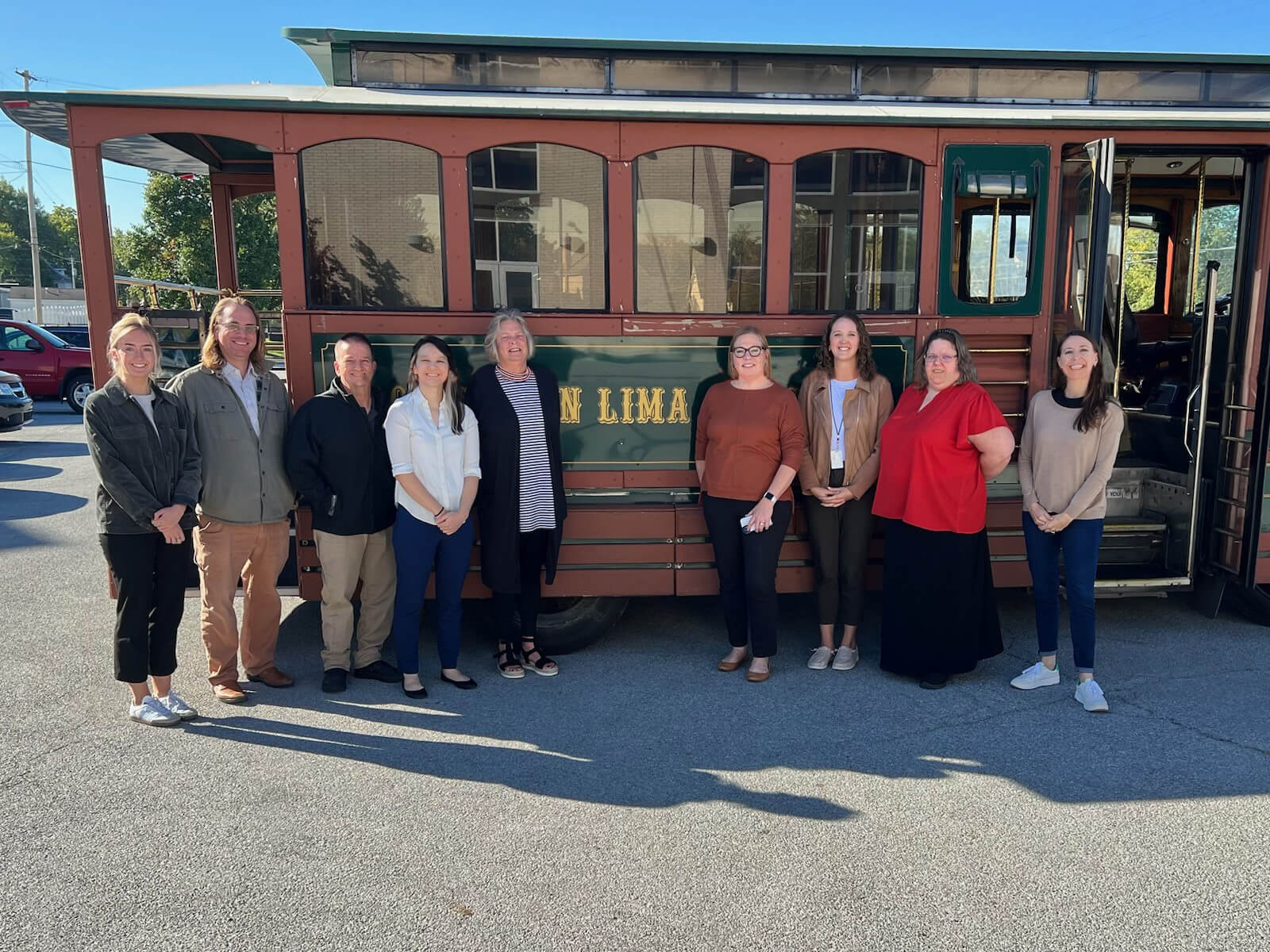A summary of ACEEE’s work with Lima, Ohio through the U.S. Department of Transportation Thriving Communities Technical Assistance Program.
View additional case studies:
Lansing, Michigan | St. Louis County, Missouri | Sumter, South Carolina
Learn more about ACEEE as Capacity Builder for U.S. Department of Transportation Thriving Communities Program

Above: Spring Street near the intersection with Main Street in downtown Lima. In 2023 and 2024, as part of downtown revitalization efforts, the City of Lima worked to implement streetscape improvements on Spring Street, including a new midblock pedestrian crossing, curb extensions, bistro lights, new trees, an archway, and removable bollards for events.
About Thriving Communities
The Thriving Communities Program (TCP), a U.S. Department of Transportation technical assistance initiative, is designed to support under-resourced communities in overcoming barriers to planning, funding, and implementing projects and initiatives that will expand affordable transportation options, reduce pollution, improve public health, support job creation, and achieve other community goals. Communities were selected to participate through a competitive application process. ACEEE was selected as part of a capacity builder team to provide technical assistance and worked closely with four communities across 2023–2025.
An overview of Lima
The City of Lima, Ohio is located in northwest Ohio and serves as the seat of Allen County. The city’s population (35,579 as of the 2020 U.S. Census) peaked in the 1970s and is projected to continue declining over the coming decades. Lima faces challenges familiar to many smaller Rust Belt communities that are struggling to retain population in the wake of the steady decline of the manufacturing and industrial sectors as cornerstones of the local economy. Portions of downtown Lima are recognized as Opportunity Zones (federally designated economically distressed areas), and the city is considered disadvantaged in terms of transportation cost burden, poverty rate, and several health factors, including air quality.1
Recent planning efforts, such as the City’s 2040 Comprehensive Plan, call for renewed investment in downtown Lima. This revitalization will require coordinated, strategic transportation infrastructure investments that support the community’s priorities and vision.
TCP initiatives
In applying to participate in TCP, the City of Lima noted an interest in improving public engagement in the transportation planning process, leveraging federal discretionary grant programs, and using data-driven methods to plan for streetscape improvements that enhance the experience of public transit riders. ACEEE developed customized technical assistance materials and engaged in biweekly coordination calls with the Lima TCP team over the 20-month program to support local leaders in building new capacity in these areas.
Key takeaways and insights
|
Launching a community ambassador program to support proactive public engagement
Community engagement was a key focus area of Lima’s TCP work plan, as the City Division of Engineering looked to implement best practices for increasing public involvement in the transportation planning process with limited resources. ACEEE worked with Lima to develop, launch, and maintain a new forum for ongoing engagement, called the City of Lima Community Ambassador Pilot Program (“ambassador program”).
The ambassador program brought together trusted leaders from a cross-section of the community, including staff and board members from various nonprofit, business, and neighborhood groups, to inform Lima’s upcoming Safe Streets for All (SS4A) planning process. These leaders took a proactive and community-led approach to identifying safety needs and priorities across Lima’s public streets. Beyond the SS4A process, the ambassador program creates a framework for an ongoing feedback loop between city staff and community members on transportation needs, priorities, and upcoming projects.
The ambassador program met in person as well as virtually throughout the program. City staff as well as partners from Lima-Allen County Regional Planning Commission, the local Metropolitan Planning Organization (MPO) in Lima, facilitated interactive engagement with the ambassadors between regular meetings.
To support community engagement initiatives tied to transportation safety planning, ACEEE prepared a customized Walk Audit Toolkit for Lima. Walk audits are events where community residents and other local stakeholders gather to walk or observe conditions on a specific roadway in the community to collect information—observations, concerns, ideas, and other notes—about the location to inform future projects. The ACEEE-developed toolkit, which included three different templates for observation forms to support walk audits at various types of locations, will support the City and MPO in engagement efforts for a wide variety of transportation projects. In March 2025, city and MPO staff convened community ambassadors for a walk audit using these materials to assess conditions on Union Street in downtown Lima ahead of an upcoming project on that corridor.

Above: City of Lima staff, MPO staff, and community ambassadors conduct a walk audit along Union Street. Image credit: City of Lima
Outside of the ambassador program, the community also worked with the program lead at the Lima Adult Learning Center to discuss public engagement opportunities. To reach out to sectors of the community that have historically been underrepresented in local planning efforts, the City Engineer attended several in-person classes at the learning center and at the Worth Center, an alternative correctional facility in Allen County, in April and May 2025 to conduct a survey on transportation safety priorities.
More than 100 students across a dozen different adult-learning classes shared their feedback during this outreach, providing the City of Lima with invaluable insight from a non-traditional stakeholder group that would have otherwise been difficult to engage. Like the focus of the walk audit program, the survey responses will help inform the upcoming SS4A planning process.
Using demographic and geospatial analysis to prioritize upgrades to transit stops and other pedestrian infrastructure
Through TCP, local partners in Lima also sought ACEEE’s assistance with collecting and analyzing data to inform which bus stops the city should focus on when installing adjacent concrete boarding/alighting areas and other accessibility upgrades. The analysis will support the City and the local public transit agency, the Allen County Regional Transit Authority (RTA), in collaborative efforts to improve safety, access, and equity across the community by enhancing the ridership experience for transit users.
To support the transit improvements, ACEEE prepared a data-driven prioritization methodology for local partners. Using demographic data from the American Community Survey, local transit ridership data, and local data on existing pedestrian facilities as well as high-priority community destinations, ACEEE prepared a geospatial analysis in GIS for Lima that layers these data sources to generate a prioritized set of locations for future upgrades. This methodology is something that Lima can build upon moving forward as it looks to prioritize other similar investments, helping shed light on where limited resources can have the biggest impact.
Supporting grant applications for federal funding
ACEEE also supported the City of Lima’s 2024 application for the Safe Streets for All (SS4A) Planning and Demonstration Grant to develop a comprehensive safety action plan, a transportation plan that is intended to identify high-priority areas for safety improvements and detail a timeline for their completion. ACEEE worked closely with the Lima team to review the 2024 grant criteria to ensure that Lima’s application sufficiently met the necessary requirements and provided in-depth feedback on the grant narrative. Lima was awarded the SS4A grant, the city’s first discretionary federal grant.

Representatives from the Lima TCP team gather for a group photo in October 2024. From left to right: Jackie Lombardi (RMI), Ian Kohli (City of Lima), Dave Louth (City of Lima), Christi Nakajima (ACEEE), Karen Garland (RTA), Megan Kinnear (Lima-Allen County Regional Planning Commission), Jessica Begonia (City of Lima), Tonya Dye (Lima-Allen County Regional Planning Commission), and Caroline Daigle (ACEEE).
Summary of impact
After participating in the Thriving Communities Program, public sector partners in Lima are better equipped to deliver transformative, data-driven transportation projects that respond to the community’s needs and priorities. With ACEEE’s support, staff from multiple public agencies in the city are positioned to continue the Community Ambassador Program, which offers a promising framework for maximizing the reach of public engagement for transportation projects. Similarly, ACEEE’s technical mapping exercise has provided the City Engineer and the local public transit agency with a prioritized list of locations for transit accessibility improvements that they are working together to implement. Finally, Lima is eager to launch its planning process for the Safe Streets for All comprehensive safety action plan, and guidance from ACEEE has prepared local leaders to tap into future competitive grant opportunities that they may have otherwise not pursued.
1 Data were accessed by ACEEE in December 2023, before this tool was removed from USDOT’s website in January 2025. More information can be found here: https://eelp.law.harvard.edu/wp-content/uploads/2024/02/ETCE-User-Guide…




